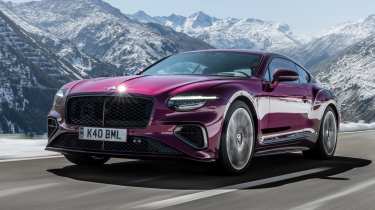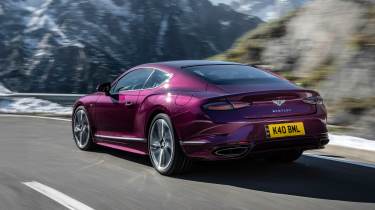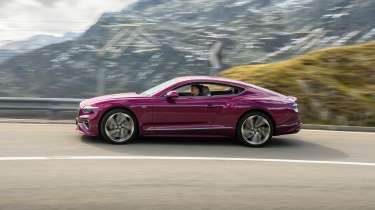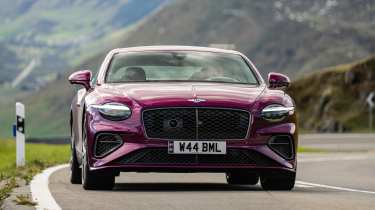Bentley Continental GT Speed 2024 review – driving the most powerful Bentley yet
The latest Continental GT is the beginning of a new plug-in hybrid era for Bentley. Is it still a benchmark grand tourer?
Step inside the new Bentley Continental GT. No need to slam the door; pull it gently against the catch and it’ll softly motor itself closed, while the motorised ‘butler’ armature proffers the seatbelt over your shoulder. Depending on spec, you might be inhaling lungfuls of leather or sitting on smart suede; behind a carbonfibre dash with black chrome, or engine-turned aluminium with trad brightwork, or walnut, koa, oak or perhaps eucalyptus veneer.
Press the starter button and, initially, there’s silence. Since the new Conti GT is a hybrid, it defaults to electric mode on start-up. The new 4-litre-V8-plus-e-motor set-up replaces both the non-hybrid 4-litre engine option in the previous Continental and the now-retired flagship W12. It has the firepower to outpoint both: with a 771bhp total output, this is the most powerful production Bentley yet. The 140kW electric motor is fed by a 25.9kWh battery, and can enable a WLTP-rated 50-mile range at up to 87mph. The engine won’t kick in unless you push the throttle past three-quarters of its travel, or twist the drive mode dial to Sport. The V8 starts with a muted whoomph, and does so instantly since there’s no traditional starter motor. The e-motor, located in the same casing as the eight-speed dual-clutch transmission, does the job of starter motor and generator, as well as driving the wheels. In electric-only mode, it has enough performance to smoothly keep pace with most traffic without assistance from the V8.
When the V8 is in play, it has an enjoyable cross-plane rumble, and Bentley is proud to point out that the woofly tones entering the cabin aren't enhanced in any way; it’s all real engine sound. The V8 generates 591bhp on its own. Like the rest of the hybrid system, the engine is shared with the latest Porsche Panamera E-Hybrid. The 3996cc block is retained from the previous Conti and Panam’s V8 but there’s new 350bar fuel injection (up from 200bar in the previous V8) and new turbos (since the electric motor helps with torque-fill, they’re now simpler single-scroll turbos, which can run harder for longer, helping with emissions) among multiple other refinements. And there’s no longer cylinder deactivation: since the electric motor can take over under low loads, the whole engine switches off instead.
More reviews
In-depth reviews
Reviews
- Bentley Continental GTC Speed 2025 review – huge power, huge weight, huge price
- Bentley Continental GT Speed 2024 review – driving the most powerful Bentley yet
- New Bentley Continental GT hybrid prototype review: Bentley’s most powerful road car ever
- Bentley Continental GT S 2023 review
- Bentley Continental GT Speed Convertible 2021 review – British grand touring on form
- 2021 Bentley Continental GT Speed review - Ultimate GT set to take on DB11 AMR V12
Aside from pure electric running, the hybrid powertrain also has modes in which it works together with the engine to boost acceleration, prioritise energy recuperation or charge the battery directly from the engine. You could feasibly never plug this car in; if you do, it takes around two hours 45 minutes to top the battery up fully at a fast charger. WLTP-rated total range is well over 500 miles – just the job for a continent-crossing grand tourer.
The Conti GT is a big deal for Bentley. If sales continue at their current rate, Crewe will build its 100,000th Continental GT in early 2025. The question ahead of this first drive is, has hybridisation reduced or enhanced its unique appeal?
The international launch is centred around the Adula Alps in Switzerland. Here, the hybrid powertrain suits the GT character well: gliding through villages in electric mode, with V8 power and bombast on tap for mountain passes when you need or want it. The fixed-ratio power steering is a fast set-up, aided by standard-fit four-wheel steering. You don’t need much lock, even for Alpine hairpins. It’s more natural in feel than most systems of this type; you don’t always notice it on the move, even though when you leave a parking space onlookers can see the rear wheels turning the opposite way to the fronts.
Transfer between motor and engine is very smooth, as are the gearchanges. As well as using its 332lb ft to torque-fill at low engine speeds, it employs the same trick during upshifts for a smooth, seamless feel. The suspension, too, is TV-news-anchor smooth. Bentley’s engineering team describe this car’s new electronically controlled two-valve dampers (on two-chamber air springs) as its ‘secret weapon.’ They have a much wider spread between their firmest and softest modes, and the ECU can control compression and rebound separately. There’s a little surface fuzz from the 22-inch wheels but overall ride quality and composure is very impressive.
Like the previous Conti GT, the new car is fitted with 48V active anti-roll bars, under the Bentley Dynamic Ride label. On paper this car should corner just as well as, or even better than, its predecessor, despite being more than 180kg heavier: it has a sweet 49:51 front:rear weight distribution (helped by siting the battery behind the rear axle), software for the active all-wheel-drive system and rear e-diff has been carefully refined, and it has active torque vectoring front to rear via a centre diff, and side to side using the brakes. In practice, there were limited opportunities to explore the handling during the launch. Although the Swiss Alpine scenery is so beautiful that it feels like driving inside a living screensaver, the downside is a strictly enforced 50mph speed limit and long convoys of tourist traffic ambling along rather more slowly than that, with few safe overtaking opportunities.
I did find a few quiet hairpins, and there’s a lot to like: the torque split feels notably rear biased, and the car feels more playful under power than its predecessor. Although the steering isn’t brimming with feel – it’s a luxury GT car, after all – you feel well in touch with what the tyres are up to through the chassis’ feedback and balance. Front-end grip is keen, and the Conti feels a lighter car than its 2459kg official kerb weight. But more detailed understanding of how this car handles will have to wait until we next get behind the wheel.
It stops well too, although I’m undecided about the brakes; not because they lack stopping power, but because pedal feel was a little odd at times. Bentley has gone to painstaking lengths to ensure the friction brakes and electric motor regenerative braking blend seamlessly but there were times when to me it felt less consistent than a non-hybrid car’s brake pedal. Iron brakes are standard and this test car was on the optional larger carbon-silicon-carbide brakes (both use 10-piston front, four-piston rear calipers), which perhaps are less progressive in feel.
The new Continental GT is launching in flagship Speed trim first; further, less powerful derivatives will follow. The Speed lives up to its name. When there’s the space and vision to do so, it goes well: peak torque – all 738lb ft of it – comes in at relatively low revs, circa 200rpm, due to the engine and e-motor working together, and even up at high revs, there’s more torque than the W12 engine in the previous Conti GT Speed. It makes a good noise too, without spoiling the car’s isolated refinement. It sounds even better with the roof down: Bentley is launching the new car in both coupe GT and convertible GTC guise at the same time. We tried both. The convertible is heavier, with a kerb weight of 2636kg compared with the coupe’s 2459kg, and as you’d expect you can feel a little less torsional rigidity in the drop-top version, but not dramatically so: it’s a composed and together machine. And on these roads, it’s all the better to drink in the scenery; being a sun-seeking convertible suits the Conti’s character just as much as being a capsule-like luxury coupe.
This is a comprehensive revision of the previous Continental GT rather than a clean-sheet replacement; Bentley says that around 68 per cent of components are new, with the new 400-volt architecture a key enabler for the hybridised platform’s abilities.
Much of the interior is recognisable from before, with new digital displays and trim. Quality is still superb; it’s a standout-special cabin, and a core part of the Conti’s appeal. The party-piece rotating dash is still an option, too. The seats – which include ‘wellness’ options for massage and ventilation functions – are a remarkable piece of engineering in themselves, although, like the previous car, I wish the driver’s seat could be set a bit lower.
As a Grand Tourer, the new Continental has all of the strengths of its predecessor – apart, that is, from some of its luggage space, since the hybrid system’s battery has eaten into boot space. Otherwise, it’s made the car faster, widened its breadth of abilities, and potentially opened the car up to a wider range of customers thanks to – for the first time for the Continental GT – relatively friendly BIK tax rates.
It still has the same continent-crossing comfort, sense of presence, and an enjoyable soundtrack: the V8 is a truly characterful engine and the hybrid powertrain is integrated in such a way as to expand the car’s repertoire rather than restrict it. With more exposure to the GT at higher speeds, perhaps the increased weight will make itself known – this is a 2.5-tonne car after all. But on this first impression, hybrid power suits the Continental.
Price and rivals
Bentley doesn’t name-check rivals directly but the Aston Martin DB12 and Ferrari Roma are referenced as competitors. Both have a more overtly sporting approach, sitting closer to ‘sports car’ than ‘GT’ on a sliding scale; the Bentley feels closer to a more traditional long-distance grand tourer. There’s also the Maserati GranTurismo, a truly practical GT albeit one that can’t hold a candle to the Bentley’s interior design and cabin quality.
Price has increased by around £15,000 over the previous Conti GT. At launch, the GT Speed costs £236,600 and the GTC Speed £259,500 – significantly more than the Maserati and Aston, and more too than the Ferrari Roma at the time of writing.







